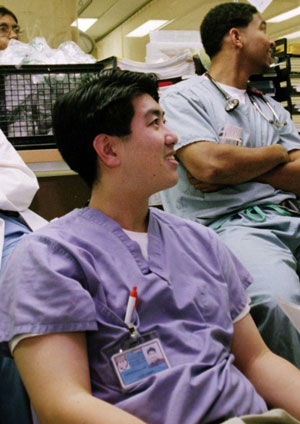- Home
- News
- Features
- Topics
- Labor
- Management
- Opinions/Blogs
- Tools & Resources
Male Nurses More Common, Numbers Triple Since 1970
Male nurses aren’t as rare as they used to be. More men are becoming RNs.
While the nursing profession remains overwhelmingly female, number of male nurses has tripled during the past 40 years, according to a new U.S. Census Bureau study.
In 2011 330,000 men were employed as nurses in the United States, about 9.6% of all nurses.
The proportion of male registered nurses more than tripled since 1970, from 2.7% to 9.6% in 2011.
The proportion of male licensed practical and licensed vocational nurses more than doubled from 3.9% to 8.1% during the same period.
The study, Men in Nursing Occupations, is based on the 2011 American Community Survey. The report analyzed the percentage of men in each of the detailed nursing occupations: registered nurse, nurse anesthetist, nurse practitioner, and licensed practical and licensed vocational nurse.
“The aging of our population has fueled an increasing demand for long-term care and end-of-life services,” said the report’s author, Liana Christin Landivar, a sociologist in the Census Bureau’s Industry and Occupation Statistics Branch.
“A predicted shortage has led to recruiting and retraining efforts to increase the pool of nurses. These efforts have included recruiting men into nursing.”
The Census Bureau study looked at a wide range of characteristics of men and women in nursing occupations. The study gathered and analyzed information about employment status, age, race, Hispanic origin, citizenship, educational attainment, work hours, time of departure to work, median earnings, industry and class of nursing workers.
Male Nurses Needed Now More Than Ever
Getting more men into the nursing profession is important to help some men talk about and get treatment for conditions they might not be comfortable discussing with female nurse.
Randy Jones an RN and associate professor of nursing at the University of Virginia conducts prostate cancer research into.
Male patients, Jones says, may feel more comfortable discussing certain conditions, especially those related to sexual and reproductive health, with other men than with women.
Men are needed in the nursing profession for another more compelling reason. By 2025 the nation is projected to have a nursing shortage, a deficit of 260,000 nurses, according to a 2009 Health Affairs article
“The shortage of the future will likely not be solved unless men are part of the equation,” says William T. Lecher, RN, and president of the American Assembly for Men in Nursing. http://aamn.org/ “We really have to figure out how to provide more gender inclusion and balance in the nursing workforce.”
Male Nurses Earn More
Despite being in the minority in nursing, male nurses still have one advantage over all of their female peers.
Even in the female-dominated nursing field, men typically earn more than women, but the gap is not as large as across all occupations.
For example, women working as nurses full time, year-round earned 91 cents for every dollar male nurses earned. In contrast, women earned 77 cents to the dollar men earned across all occupations.
Because the demand for skilled nursing care is so high, nurses have very low unemployment rates.
Unemployment was lowest among nurse practitioners and nurse anesthetists, about 0.8% for both.
For registered nurses and licensed practical and licensed vocational nurses, these rates were a bit higher, but still very low, at 1.8% and 4.3%, respectively.
Other Findings From The Male Nurses Study:
- There were 3.5 million employed nurses in 2011, about 3.2 million of whom were female and 330,000 male.
- In 2011, 9.6% of all nurses were men while 91.4% were women.
- Male nurses earned, on average, $60,700 per year.
- Female nurses earned $51,100 per year on average.
- Of the employed nurses (both sexes), 78% were registered nurses, 19% were licensed practical and licensed vocational nurses, 3% were nurse practitioners, and 1% were nurse anesthetists.
- Most registered nurses , 72%, (both sexes) left home for work between 5 am and 11:59 am.
- A sizable minority, 19%, worked the evening or night shifts.
- The majority of registered nurses (both sexes) worked in hospitals, 64%.
- The majority of licensed practical and licensed vocational nurses worked in nursing care facilities or hospitals, about 30% each. The percentages for hospitals and nursing care facilities are not significantly different from each other.
- Men’s representation was highest among nurse anesthetists at 41%.
- Male nurse anesthetists earned more than twice as much as the male average for all nursing occupations: $162,900 versus $60,700.
Please subscribe to WWOW’s post by email:
[subscribe2]
List your business in the premium web directory for free This website is listed under Human Resources Directory





